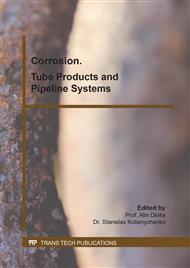[1]
Life of microbes in extreme conditions, Moscow: World, (1981).
Google Scholar
[2]
Corrosion costs: recent US study shows just how much, Pipes and Pipelines Int., 47(6) (2002) 3-4.
Google Scholar
[3]
M.V. Ivanov, A role of microorganisms in formation of hydrogen sulfide, The Role of microorganisms in circulation of gases in the nature. Moscow: Science, 1986, pp.114-130.
Google Scholar
[4]
J.A. Hardy, J.L. Brown, Sulphate-reducing bacteria: their contribution to the corrosion process // Corrosion, 40(12) (1984) 650-654.
Google Scholar
[5]
Zh.P. Kopteva, L.M. Purish, E.I. Andreyuk, I.S. Poegrebova, O.X. Tuovinen, Microbic corrosion and protection underground metal construction, Рractice corrosion protection, 3 (1999) 21-27.
Google Scholar
[6]
A.V. Vatsurina, T.Z. Esikova, V.P. Holodenko, M.B. Weinstein, V.I. Dubkova, Applied biochemistry and microbiology. Corrosion of samples of pipeline steel and the interfaced transformation of sulfuric connections by thionew bacteria of Halothiobacillus neapolitanus DSM 15147, 41(5) (2005) 564-567.
DOI: 10.1007/s10438-005-0089-2
Google Scholar
[7]
G.A. Zavarzin, Hydrogen bacteria and karboksidobakteriya, Moscow, Science, (1978).
Google Scholar
[8]
E.I. Andreyuk, I.A. Kozlov, Litotrofnye of a bacterium and microbiological corrosion, Kiev: Naukova thought, (1977).
Google Scholar
[9]
N.S. Antonovskaya, I.A. Kozlova, E.I. Andreyuk, Distribution of the sulfate-reducing bacteria in soil near the gas pipeline, Mikrobiol, 47(2) (198) 93-94.
Google Scholar
[10]
N. Kip, J.A. Van Veen, The dual role of microbes in corrosion. The ISME Journal: International Society for microbial ecology, 9(3) (2015) 542–551.
DOI: 10.1038/ismej.2014.169
Google Scholar
[11]
I.G. Rodionova, A.I. Zaitsev, O.N. Baklanova, A.Yu. Kazankov, V.V. Naumenko, G.V. Semernin, Effect of Carbon Steel Structural Inhomogeneity on Corrosion Resistance in Chlorine-Containing Media, Metallurgist, 59(9) (2016) 774-783.
DOI: 10.1007/s11015-016-0173-2
Google Scholar
[12]
M.G. Chesnokova, V.V. Shalay, Yu.A. Krauss, A.Yu. Mironov, E.G. Blinova, Informational content of an indicator of biocorrosion activity for identification of nature of aggression of soil, Hygiene and sanitation. 95(6) (2016) 513-517.
DOI: 10.18821/00169900-2016-95-6-513-517
Google Scholar
[13]
M.G. Chesnokova, V.V. Shalaj, Y.A. Kraus, et al., Analysis of corrosion defects on oil pipeline surface using scanning electron microscopy and soil thionic and sulfate-reducing bacteria quantification, Procedia Engineering. 152 (2016) 247-250.
DOI: 10.1016/j.proeng.2016.07.698
Google Scholar
[14]
M.G. Chesnokova, V.V. Shalay, Yu.A. Krauss, A.Yu. Mironov, Biocorrosion activity of soil on routes of the oil pipeline of Krasnodar Krai, Oil economy of 2016, 9 (2016) 102-105.
Google Scholar
[15]
S. Kato, I. Yumoto, Y. Kamagata, Isolation of Acetogenic Bacteria That Induce Biocorrosion by Utilizing Metallic Iron as the Sole Electron Donor, Applied and Environmental Microbiology. 81(1) (2015) 67-73.
DOI: 10.1128/aem.02767-14
Google Scholar
[16]
B.J. Little, J.S. Lee, R.I. Ray, Diagnosing microbiologically influenced corrosion. A State-of-the-Art Review. Corrosion, 62 (2006) 1006-1017.
DOI: 10.5006/1.3278228
Google Scholar
[17]
O.V. Zaytseva, N.A. Klyonova, Microbiological corrosion of oil and gas pipelines and alloying of steel for fight against it, Oil economy, 4 (2008) 92-95.
Google Scholar
[18]
H.A. Videla, Prevention and control of biocorrosion, International Biodeterioration Biodegradation, 49 (2002) 259-270.
DOI: 10.1016/s0964-8305(02)00053-7
Google Scholar
[19]
R.A. Harisov, F.R. Habirova, F.M. Mustafin, Main reasons for appearance of defects of insolating coverings. Oil and gas business, 4 (2005) 10-18.
Google Scholar
[20]
S.Y. Nizhegorodov, S.A. Voloskov, V.A. Trusov, L.M. Kaputkina, T.A. Sur, Corrosion steel under the influence of microorganisms, Metallurgical science and heat treatment of metals. 4 (2008) 44-48.
Google Scholar



